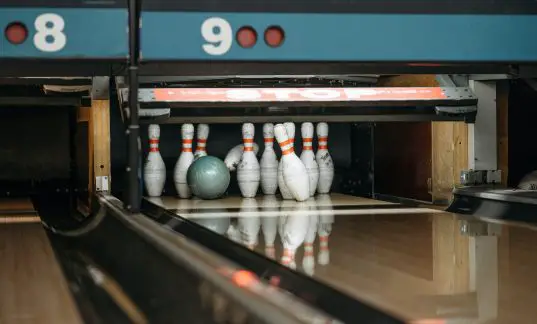If you’re looking up new bowling balls on Google, you’re unlikely to find many pre-drilled balls worth buying. That’s because you should also have a new bowling ball drilled for your particular shot style and needs.
A good pro shop will measure your hand for you and determine the depth and width of finger holes based on your particular measurements. Also, they will allow you to choose a layout that will help you bowl with more confidence and lean into your strengths as a bowler.
As lane conditions get tricker and you’re faced with more complex oil pattern configurations as an intermediate or expert bowler, it pays to have bowling balls that you have complete control over. And whether you use finger inserts for a fingertip grip (or semi-fingertip grip), or just go au natural and push for more power with a straighter shot, you should always let a pro’s drill bit fit a ball to your hand and throwing style.
Here’s why.
Why is bowling ball drilling so important when buying a new bowling ball?
The newest wave of reactive resin bowling balls are wonders of tactile technology. How you drill a new bowling ball affects everything from the rev rate you can generate to the optimum ball speed you’re able to achieve. And with an array of complex core configurations and differing placements for mass bias markers and locator pins, where you begin to drill on the surface of a bowling ball will change how your ball performs in the heat of competitive action.
The trick is to use the data about your ball, its coverstock, and its core configuration to best determine the drilling layout for you. Sometimes, drilling holes that look way off-center are best for the entry angle you’re trying to achieve. And sometimes it pays to avoid drilling too traditionally to ensure you get maximum distance and length from your ball in wild, oily conditions.
How should I drill my bowling ball finger holes?
In truth, it’s all about what you’re looking for as a player. This is where it pays to have the input of an experienced pro shop operator. The location of your finger holes needs to be balanced with your swing, your arm span, your footwork, and the ball you’re using. When you drill a bowling ball, you need to make sure that the finger holes are helping and not hindering your ultimate aims. If you’re a straight shooter, placing the holes in such a way to maximize hook is a fool’s errand. And if you’re a hook artist, it will matter big time if your drilling layout mutes your angularity.
How does drilling holes into a brand-new bowling ball affect how the ball behaves?
We’ll get into the different types of bowling ball finger hole layouts in a second. But, the shorthand answer for this question is pretty simple — the strength and placement of your layout could spell the difference between boosting and tanking your scoring average. This is especially true if you’re purchasing an aggressive bowling ball with a high-tech coverstock made to eat oil and get angular. The wrong layout will make your ball hard to control and hard to slot into the pin pocket with efficacy.
If you watch professional bowling videos on YouTube, you are watching the synergy of small finger hole layouts and top-tier bowling ball technology. If your ball gets wild on you when the chips are down, it may be a sign that your finger holes aren’t placed just right.
What are the different layouts to ask for when getting a bowling ball drilled?
Most bowling ball manufacturers release specification sheets with their products that diagram the different drilling layouts for that particular ball. And while the actual placements of the finger holes differ with varied core technologies and coverstocks, three common layout styles are used regardless.
A weak layout is a good bet for medium-high and high rev players that are trying to avoid unpredictable snapping motions at the end of the lane. This layout favors a more muted backend reaction, pushing the ball out of its skid sooner to maximize control. If you are looking to hook a bit less overall and control your backend more, this is the way to go.
A strong layout is best for lower rev players that want the benefit of a big-time backend reaction that will push their ball back towards the pocket late. If you want pure angularity at the breakpoint and a longer skid through the heads and middle of the lane, here’s your option. This is also a great way to get your hook moving in dry or depleted lane conditions.
If you’re playing on house shots more often than not and want a balanced drilling layout, go with a control layout. It offers a solid amount of front-end skid without going too far. And it offers good angularity at the breakpoint without getting too wild. It’s the perfect balance of aggression and consistency for an intermediate or advanced player that wants to let their skill do the talking.
How does a pro shop decide which layout will work for you?
The more information about your shot that a pro shop has, the better things will be. And it’s best if you come in prepared. What kind of ball motion are you in search of? What are your perceived strengths and weaknesses?
Furthermore, let the pro shop see your delivery and monitor everything from your ball speed to your axis tilt and rotation. The more they know and the more they can pinpoint how your shot works, the easier time they’ll have picking a layout that works wonders for you.
Frequently Asked Questions
How does a bowling ball’s core affect ball speed and ball reaction?
In short, asymmetrical cores are best for high-speed players who want more angular reactions — provided that the drilling layout and coverstock are working in concert with that. A symmetrical core is better for low-to-medium speed bowlers who want more consistent reactions with less total hook. There are exceptions to these rules, but this is the general gist of things.
Does not using the thumb hole change ball motion?
Using a two-finger hole without inserting your thumb can help you get more total hook and control that hook better. Some bowlers don’t use a thumb hole because they just don’t like it. Others eschew the thumb hole to sharpen their hook and get more creative on the back end.
What is a fingertip grip?
To execute a fingertip grip, insert your thumb fully. However, only insert your other two bowling fingers to the first knuckle joint. You can use finger inserts to aid this or just control it yourself. This promotes more angularity and helps you potentially maximize your total hook.
What is a semi-fingertip grip?
A semi-fingertip grip starts with inserting your thumb fully. However, you should only insert your other two fingers to the mid-point between the first and second knuckle joint. This ups your hook potential while giving you more control and predictability than a pure fingertip grip.
Should I own multiple bowling balls with holes drilled differently?
It depends on the type of bowling balls and the ball motion you need. Sometimes, it pays to have a spare ball drilled one way for straight-shooting and a strike ball drilled for sharp hooks. However, it’s up to you and the help of your local pro shop to find out a ball arsenal that works for you — drilling layouts and all.
Can you re-drill the same ball you’ve used before?
Yes. There are plug and re-drill procedures out there that will allow you to take another stab at improving your game with a different drilling configuration.
How does bowling style factor into drilling a bowling ball?
A lot. Your local pro shop operator will want to know as much as possible about your style and shot to give you the best layout that accentuates your positives and minimizes your negatives.
Closing Thoughts
A true bowling enthusiast doesn’t play with a ball uncomfortable as can be. They know the value of well-placed gripping holes and smart drilling layouts that help a bowler command their rev rate and up their game. Get your axis tilt on lock and save the first knuckle joint and second knuckle joint of your throwing fingers some stress. Head over to your local pro shop with this page bookmarked and become one of those smart bowlers that turn knowledge into pure pin action.

